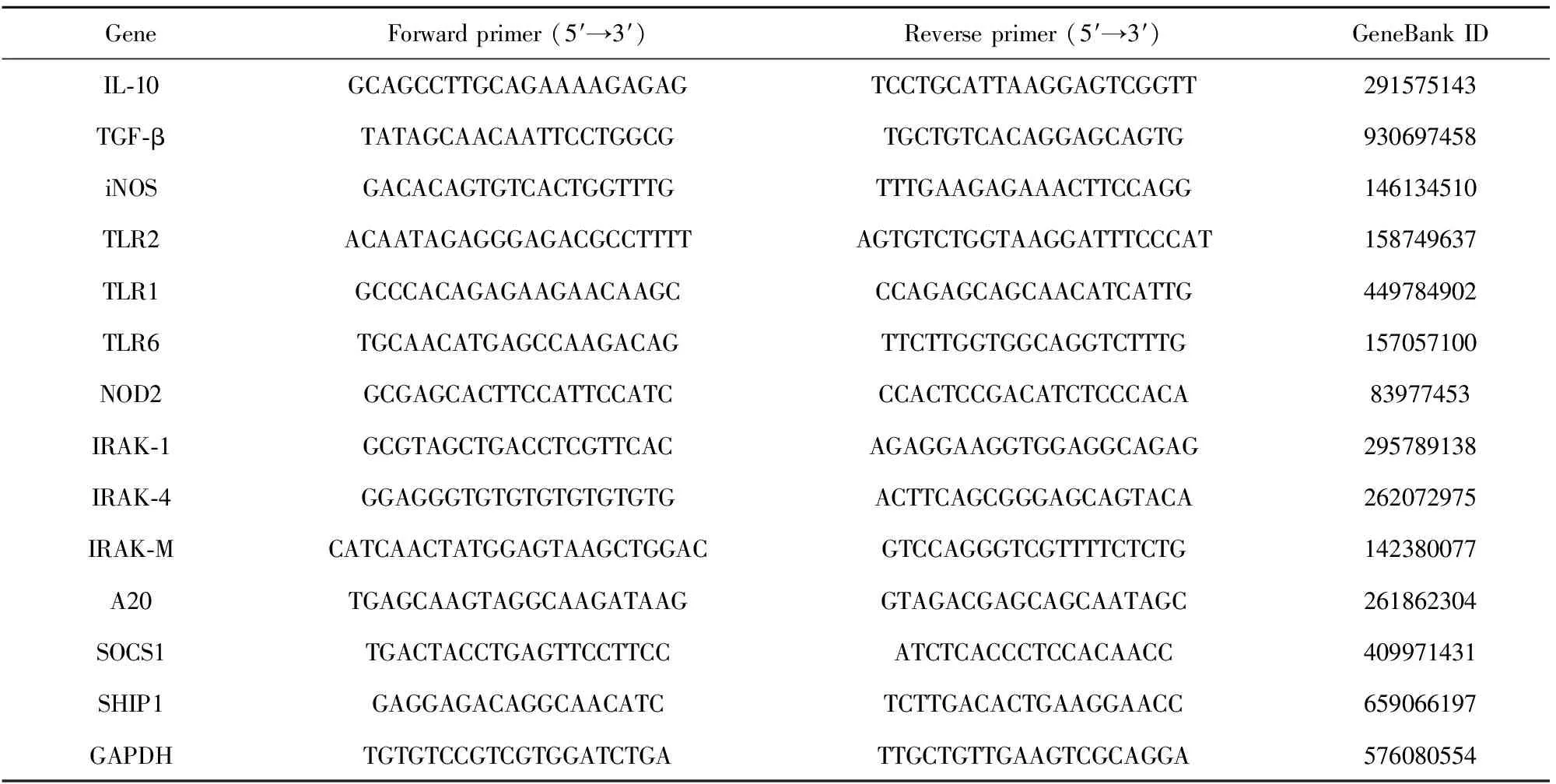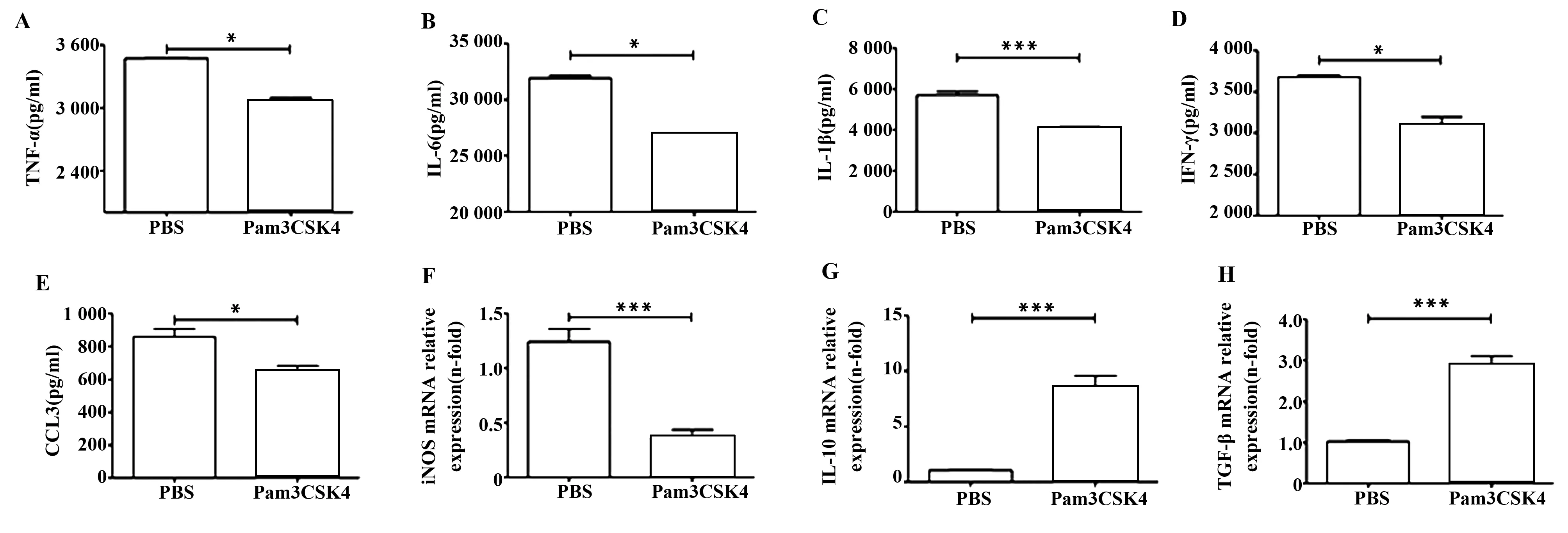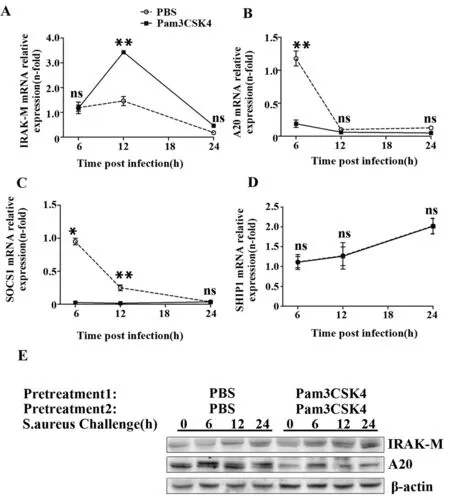在MRSA系统性感染模型中Pam3CSK4预处理降低小鼠肾组织的炎症反应①
2017-10-24黄钊霞易夏玉侯晓睿王湘豫刘北一
黄钊霞 易夏玉 侯晓睿 王湘豫 朱 平 刘北一
(南方医科大学基础医学院免疫学教研室,广州 510515)
·临床免疫学·
在MRSA系统性感染模型中Pam3CSK4预处理降低小鼠肾组织的炎症反应①
黄钊霞 易夏玉 侯晓睿 王湘豫 朱 平 刘北一
(南方医科大学基础医学院免疫学教研室,广州 510515)
目的在耐甲氧西林金葡菌(MRSA)系统性感染模型中,观察低剂量TLR2激动剂Pam3CSK4预处理对小鼠肾组织中炎症反应的影响并初步探讨其机制。方法于感染前48 h、24 h对BALB/c小鼠行尾静脉注射 Pam3CSK4 (10 μg/100 μl/只);2×107CFU/只MRSA经静脉感染小鼠,ELISA和荧光实时定量PCR(Q-PCR)检测细胞因子水平,Q-PCR检测TLR2、IRAKs等相对表达量,Western blot检测NF-κB p65磷酸化、IRAK-M及A20表达。结果与对照组相比,预处理组在感染6 h后肾组织中TNF-α、IL-6、IL-1β、CCL3和IFN-γ含量显著减少,iNOS表达量降低,IL-10和TGF-β表达量增高,TLR2表达下降;处理组肾组织在感染12 h后IRAK-1表达无明显增加,而IRAK-M表达量显著增加;Western blot结果显示Pam3CSK4预处理组NF-κBp65磷酸化降低,IRAK-M表达明显增高。结论Pam3CSK4预处理降低MRSA系统性感染小鼠肾组织的炎症反应,这可能与诱导IRAK-M表达相关。
TLR2;Pam3CSK4;耐甲氧西林金葡菌;炎症;IRAK-M
金黄色葡萄球菌(Staphylococcus aureus,S.aureus)是一种常见的G+菌,是社区和院内感染的主要致病菌之一,除可引起轻度的皮肤和软组织感染外,还可引发危及生命的肺炎、心内膜炎、脓毒症等[1]。由于抗生素广泛应用,导致细菌耐药情况严重,甚至出现耐甲氧西林(MRSA)和耐万古霉素的超级耐药菌,给临床治疗带来极大困难。机体在应对感染中产生大量促炎性细胞因子以增强中性粒细胞及单核-巨噬细胞清除细菌,然而促炎性细胞因子的过度分泌则导致组织损伤,甚至参与脓毒症性休克、多器官功能衰竭的发生与发展[2],因此在针对MRSA系统性感染中,除寻找新型抗生素药物外,人们尝试利用免疫调节以达到抗感染和炎症反应的平衡。
TLR2是重要的模式识别受体,广泛表达于单核-巨噬细胞、树突状细胞、肥大细胞和嗜碱性粒细胞等固有免疫细胞表面[3]。TLR2与TLR1或TLR6构成异二聚体,识别G+菌中多种成分,包括肽聚糖(Peptidoglycan,PGN)、脂磷壁酸(Lipoteichoic acid,LTA)以及脂蛋白[4]。TLR2/TLR1或TLR2/TLR6在识别配体后,激活胞内Toll/IL-1 受体同源区TIR(Toll/IL-1 receptor homologous region,TIR),白介素1受体相关蛋白激酶-1(IL-1R associated kinase-1,IRAK-1)磷酸化,最终激活核因子κB(Nuclear factor κB,NF-κB)并诱导炎症因子的表达[5]。
Pam3CSK4是TLR1/TLR2配体,为人工合成的三酰脂肽。有文献表明Pam3CSK4预处理后可保护小鼠抵御MRSA感染所致肺炎、眼内炎[6,7];Pam3CSK4注射降低钩端螺旋体在仓鼠体内致病性、提高其生存率[8],但对于Pam3CSK4处理降低感染过程中炎症反应机制不清。基于肾脏是MRSA感染的主要器官,TLR2丰富表达于肾髓质处的肾小管、肾小球以及血管内皮细胞[9],本文观察Pam3CSK4预处理对MRSA菌血症模型中肾组织中炎症反应的影响,并初步探讨其降低炎症反应的机制。
1 材料与方法
1.1实验材料、试剂 4~6周龄SPF级 BALB/c小鼠购于南方医科大学实验动物中心;MRSA43300购自温州康泰生物技术有限公司;Pam3CSK4购自Invivogen公司;TNF-α、IL-6、IFN-γ、IL-1β、CCL3 ELISA试剂盒购于eBioscience公司,总RNA提取试剂盒(RNAiso Plus)、逆转录试剂盒、PCR扩增试剂盒为TaKaRa公司产品;兔抗IRAK-M 多克隆抗体和兔抗NF-κB p65单抗购自Abcam公司,兔抗phospho-NF-κB p65 (Ser468)抗体、兔抗β-actin抗体、抗A20单克隆抗体、10×RIPA及Protease/Phosphatase Inhibitor Cocktail购自CST公司;BCA蛋白定量试剂盒和ECL购于碧云天公司;引物为广州英潍捷基公司合成,其余试剂均为国产分析纯。
1.2实验方法
1.2.1MRSA(ATCC 43300)的培养 常规培养细菌至对数期(4~5 h),于600 nm处测定光密度(OD)估算细菌量(1 OD600≈1×109CFU/ml),以无菌生理盐水调整细菌至所需菌量。
1.2.2Pam3CSK4预处理及MRSA系统性感染 BALB/c小鼠(雌性,4~6周)随机分组,每组5~10只,实验组在感染前48 h、24 h分别以10 μg/(100 μl·只)连续两次尾静脉注射Pam3CSK4,对照组在同一时间点尾静脉注射无菌PBS 100 μl/只,末次处理24 h后尾静脉注射MRSA(2×107CFU/只)。
1.2.3ELISA检测细胞因子含量 按1.2.2方法预处理及感染BALB/c鼠6 h,收取同侧肾组织,于无菌PBS中研磨脏器,4℃ 2 000 r/min离心10 min,分离上清和细胞,按eBioscience ELISA试剂盒检测上清液中TNF-α、IL-6、IL-1β、CCL3和IFN-γ含量。
1.2.4real-time PCR 按1.2.2方法预处理及感染BALB/c小鼠;按1.2.3收集肾组织研磨后的细胞沉淀,提取总RNA,按TaKaRa试剂盒逆转录cDNA,real-time PCR检测肾组织中IL-10、TGF-β、iNOS、TLR2、TLR1、TLR6、NOD2、IRAK-1、IRAK-4、IRAK-M、A20、SOCS1及SHP1基因的相对表达量。引物序列见表1。
1.2.5Western blot 按1.2.2方法预处理及感染BALB/c鼠,在感染后不同时间收取预处理组和对照组小鼠同侧肾组织于研磨器中,加含Protease/Phosphatase Inhibitor Cocktail的1×RIPA,冰浴研磨,4℃ 14 000 r/min离心10 min,收取上清。BCA法蛋白定量。配制SDS-PAGE (5%积层胶、10%分离胶),以30 μg/泳道上样、电泳,电转移至PVDF膜,5%BSA/TBST封闭,洗膜后分别加兔抗Phospho-NF-κB p65(Ser468)单抗、兔抗NF-κB p65、兔抗IRAK-M及兔抗A20抗体,4℃ 过夜孵育,洗膜后加HRP-羊抗兔多抗(Jackson,1∶10 000)室温孵育2 h,洗膜后加ECL,曝光。Stripping buffer洗膜30 min,洗涤后加抗β-actin抗体室温孵育2 h,加ECL,曝光。
1.3统计学处理 统计数据采用SPSS20.0软件分析,两组间比较采用Students′t-test,不同组别间比较采用One-way ANOVA。使用Graph Pad Prism5.0软件作图。P<0.05为差异具有统计学意义。
2 结果
2.1系统性感染模型中,Pam3CSK4预处理组小鼠肾脏中炎性细胞因子含量降低,而抑炎性细胞因子表达量增高 由于肾脏是金葡菌系统性感染的首要脏器,我们首先观察Pam3CSK4预处理是否可以降低小鼠肾脏组织中促炎性细胞因子含量。结果显示与PBS处理组相比,MRSA系统性感染6 h后Pam3CSK4预处理组小鼠肾脏中TNF-α、IL-6、IL-1β、IFN-γ和CCL3含量显著降低(图1A~E);iNOSmRNA相对表达量降低(图1F)。Real-time PCR结果显示感染6 h后肾脏中具有抑制炎症反应的IL-10和TGF-β mRNA相对表达量明显升高(图1G、H)。上述结果提示在MRSA感染早期Pam3CSK4预处理降低肾脏中炎症反应。

表1 Real-time PCR引物序列

图1 系统性感染模型中Pam3CSK4预处理组小鼠肾组织中细胞因子水平Fig.1 Detection of levels of cytokines in renal tissue from mice with Pam3CSK4 or PBS treatment post MRSA systemic infectionNote:The level of TNF-α (A),IL-6 (B),IL-1β (C),IFN-γ (D),CCL3 (E) and the relative mRNA expression of iNOS (F),IL-10 (G) and TGF-β (H) in kidney from mice with Pam3CSK4 or PBS treatment post infection.Experiments were performed three times in duplicate wells and the results are shown as ±s.* .P<0.05,***.P<0.001 versus PBS pretreatment.
2.2MRSA系统性感染6 h,Pam3CSK4预处理组小鼠肾组织TLR2表达显著降低,而TLR1、TLR6、NOD2表达无明显改变 基于TLR2可分别与TLR1、TLR6形成异二聚体以识别金葡菌,以及NOD2也能识别金葡菌主要成分PGN[10],我们进一步比较在MRSA感染后两组间TLR1、TLR2、TLR6表达的区别。结果显示MRSA系统性感染6 h后,Pam3CSK4预处理组肾组织中TLR2 mRNA表达量明显降低(图2A),而TLR1、TLR6和NOD2的相对表达量在两组间无明显差别(图2B~D)。上述结果提示Pam3CSK4预处理可能通过调节TLR2信号传导通路以降低肾组织中炎症反应。
2.3MRSA系统性感染后,Pam3CSK4预处理组小鼠肾组织细胞内NF-κB p65磷酸化降低 TLR2信号通路激活后,NF-κB磷酸化、转位至细胞核,细胞因子如TNF-α、IL-6表达并分泌。基于上述促炎性细胞因子在Pam3CSK4处理组显著降低(图1),我们首先检测NF-κB p65亚单位磷酸化,WB结果显示,与对照组相比,Pam3CSK4处理组小鼠在感染0 min时NF-κBp65磷酸化即降低,至感染后60 min则无法检测到,而NF-κB p65总蛋白及作为内参的β-actin在各泳道一致(图3A),提示Pam3CSK4预处理抑制NF-κB p65激活及磷酸化。IRAKs家族中IRAK-1和IRAK-4是TLRs信号传导通路中的重要分子,TLR识别配体后,胞内IRAK-4和IRAK-1激活、磷酸化,继而激活NF-κB和细胞因子分泌,因此IRAKs分子被认为参与炎症反应、肿瘤发展[11,12]。Real-time PCR结果显示,PBS处理组IRAK-1在感染后12 h升高并达到高峰,显著高于Pam3CSK4处理组(图3B),而Pam3CSK4处理组IRAK-1在感染后6 h虽与对照组无差别,但至12 h无明显升高(图3B);两组间IRAK-4表达在感染后6~24 h无明显差别(图3C)。上述结果提示Pam3CSK4预处理抑制IRAK-1激活。
2.4MRSA系统性感染后,Pam3CSK4预处理组小鼠肾组织中IRAK-M表达显著增高 与IRAKs家族中IRAK-1和IRAK-4不同,IRAK-M没有激酶活性,是TLRs信号传导通路中的负调控分子,IRAK-M通过抑制IRAK-1激活和磷酸化,抑制IRAK-1/MyD88解离,阻断IRAK-1/TRAF6复合体形成[13,14];以及下调CD80信号而达到抑制TLR-NF-κB/AP-1通路激活[15],从而发挥负调控作用。IRAK-M丰富表达于小鼠单核-巨噬细胞、中性粒细胞、成纤维细胞和B淋巴细胞,也表达于肺、小肠和肝导管的上皮细胞;在小鼠胸腺、肝脏、心脏、脑及肾脏均表达[16,17]。基于上述观察到Pam3CSK4预处理组在感染后组织中IRAK-1表达量无明显增加(图3B),我们进一步检测可抑制IRAK-1激活的分子IRAK-M。结果显示,与PBS处理组相比,Pam3CSK4预处理组肾组织中IRAK-M表达量在感染后12 h显著升高(图4A,P<0.01),其后下降,至感染后24 h两组间IRAK-M表达无明显统计学差异(图4A)。研究表明,除IRAK-M外,SOCS1、SHP-1、A20等负调控分子也参与下调TLRs信号通路从而抑制炎症反应[14,18-20],因此我们进一步检测这些负调控分子的表达。与文献相符的是在感染早期发挥负调控作用的A20[21],在PBS组感染后6 h显著升高(图4B),其后下降,在感染后12 h至24 h两组之间无明显差别,与此不同的是,Pam3CSK4预处理组A20在感染后(0~24 h)无明显改变。在感染后6 h和12 h,PBS处理组SOCS1显著高于Pam3CSK4处理组(图4C,6 h,P<0.05;24 h,P<0.01),而Pam3CSK4处理组在感染后SOCS1无明显改变;感染后两组的SHP1表达均逐渐升高,但在两组间无明显差异(图4D)。Western blot结果进一步显示Pam3CSK4预处理组在感染后肾组织IRAK-M表达显著高于对照组,与real-time PCR结果相符的是A20却无明显增高(图4E),而PBS处理组在感染后A20明显增高,而IRAK-M表达水平无明显增加(图4E)。上述结果提示IRAK-M表达可能是参与调控Pam3CSK4预处理降低肾组织中炎症反应的关键分子。

图2 MRSA感染6 h Pam3CSK4预处理组肾组织中TLR2 mRNA相对表达量降低Fig.2 mRNA relative expression of TLR2 in renal tissue from Pam3CSK4-treated mice was significantly decreased post MRSA infectionNote:The relative mRNA expression of TLR2 (A),TLR1 (B),TLR6 (C) and NOD2 (D) were detected by using real-time PCR.Data were analyzed using the 2-ΔΔCT method;mRNA expression is shown as the fold difference compared to that from PBS-treated mice.Experiments were performed three times in duplicate wells and the results are shown as ±s.ns.No significance,* .P<0.05.

图3 MRSA感染后,Pam3CSK4预处理组小鼠肾组织中NF-κBp65磷酸化降低、IRAK-1表达量降低Fig.3 Pretreatment with Pam3CSK4 inhibit phosphorylation of NF-κB p65 and expression of IRAK-1 in renal tissue post infection with live S.aureusNote:Phosphorylation of NF-κBp65 was detected by Western blot (A).The relative mRNA expression of IRAK-1(B) and IRAK-4(C) were measured by real-time PCR.Data were analyzed using the 2-ΔΔCT method;mRNA expression is shown as the fold difference compared to that from PBS-treated mice.Experiments were performed three times in duplicate wells and the results are shown as ±s.ns.No significance,* .P<0.05 versus PBS pretreatment cells.

图4 Pam3CSK4预处理组小鼠在感染后IRAK-M表达显著增高Fig.4 Pretreatment with Pam3CSK4 induced expression of IRAK-M in renal tissue after MRSA systemic infectionNote:The relative mRNA expression of IRAK-M (A),A20 (B),SOCS1 (C) and SHIP1 (D) was detected by real-time PCR,respectively.Data were analysed using the 2-ΔΔCT method;mRNA expression is shown as the fold difference compared to that from PBS-treated mice.Experiments were performed three times in duplicate wells and the results are shown as mean ± SEM.ns.No significant;*.P<0.05,**.P<0.01 versus PBS pretreatement cells.E.The expression of IRAK-M in kidney from mice treated with PBS(left) or Pam3CSK4(right) was detected by Western blot.
3 讨论
MRSA系统性感染中促炎性细胞因子过度分泌加重机体炎症反应及组织损伤。研究表明MRSA感染以及万古霉素治疗甚至加剧急性肾损伤[22]。因此本文探讨了Pam3CSK4预处理对MRSA感染中肾组织炎症反应的调节。结果显示在MRSA感染早期(6 h)低剂量Pam3CSK4预处理小鼠肾组织中促炎性细胞因子TNF-α、IL-6、IL-1β、CCL3、IFN-γ及iNOS水平显著降低,而抑制炎症反应的IL-10、TGF-β相对表达量增高。
与以往研究不同[6,23],本文发现低剂量(10 μg/只)Pam3CSK4连续处理小鼠两次即能降低MRSA感染后的炎症反应,这种抑制炎症反应机制可能体现为针对TLR2信号通路中多个分子,如抑制TLR2表达、短暂下调TLR信号通路中IRAK-1(图3B,感染后6~12 h表达量无明显升高,此后缓慢升高,至24 h后与对照组无差别)及上调负调控分子IRAK-M(图4,感染后12 h内表达量明显增高,12~24 h迅速下降,至24 h与对照组无差别)。提示Pam3CSK4可以作为免疫调节剂调控MRSA感染中肾组织的炎症反应。
不同的TLRs配体(如LPS、PGN以及LTA)能刺激单核-巨噬细胞胞内IRAK-M表达[24-26]。IRAK-M表达降低流感病毒感染所致病理损伤以及哮喘患者中性粒细胞所诱导的组织损伤和重构[27,28],Lech等[29]研究表明在急性肾损伤中IRAK-M充分表达有利于肾组织结构和功能修复,而IRAK-M缺失则加重肾组织炎症反应,甚至促进慢性肾功能衰竭,此外IRAK-M缺陷个体易发炎性肠炎[30]。我们的研究显示Pam3CSK4预处理降低细菌感染中的炎症反应并诱导感染早期IRAK-M短暂性表达,因此IRAK-M适度表达有利于控制炎症及降低感染个体脓毒性休克和多器官衰竭的发生[16],同时也提示IRAK-M有望作为调控炎症反应的靶点。
Hu等[18]发现A20是Pam3CSK4诱导THP-1细胞耐受的关键分子;Günthner等[31]的研究表明LPS可刺激人和小鼠PBMC持续表达A20和IRAK-M,说明这两种负调控分子在抑制炎症反应中的重要性。而我们的研究显示在MRSA感染早期,Pam3CSK4预处理上调IRAK-M,但A20的表达并未明显增高,其中机制尚不清楚,推测可能与所用实验体系不同有关。
综上,本文研究表明低剂量Pam3CSK4预处理降低MRSA系统性感染中小鼠肾组织中的炎症反应,这种抑炎作用可能与感染早期降低TLR2表达、抑制IRAK-1表达和诱导IRAK-M表达相关。
[1] Lowy FD.Staphylococcus aureus infections[J].N Engl J Med,1998,339(8):520-532.
[2] Wiersinga WJ,Leopold SJ,Cranendonk DR,etal.Host innate immune responses to sepsis[J].Virulence,2014,5(1):36-44.
[3] Chang ZL.Important aspects of Toll-like receptors,ligands and their signaling pathways[J].Inflamm Res,2010,59(10):791-808.
[4] Schenk M,Belisle JT,Modlin RL.TLR2 looks at lipoproteins[J].Immunity,2009,31(6):847-849.
[5] Pietrocola G,Arciola CR,Rindi S,etal.Toll-like receptors (TLRs) in innate immune defense against Staphylococcus aureus[J].Int J Artif Organs,2011,34(9):799-810.
[6] Chen Y,Zhang Y,Deng L,etal.Control of Methicillin-Resistant Staphylococcus aureus Pneumonia Utilizing TLR2 Agonist Pam3CSK4[J].PLoS One,2016,11(3):e149233.
[7] Kochan T,Singla A,Tosi J,etal.Toll-like receptor 2 ligand pretreatment attenuates retinal microglial inflammatory response but enhances phagocytic activity toward Staphylococcus aureus[J].Infect Immun,2012,80(6):2076-2088.
[8] Zhang W,Zhang N,Xie X,etal.Toll-Like Receptor 2 Agonist Pam3CSK4 Alleviates the Pathology of Leptospirosis in Hamster[J].Infect Immun,2016,84(12):3350-3357.
[9] Shigeoka AA,Holscher TD,King AJ,etal.TLR2 is constitutively expressed within the kidney and participates in ischemic renal injury through both MyD88-dependent and-independent pathways[J].J Immunol,2007,178(10):6252-6258.
[10] Girardin SE,Boneca IG,Viala J,etal.Nod2 is a general sensor of peptidoglycan through muramyl dipeptide (MDP) detection[J].J Biol Chem,2003,278(11):8869-8872.
[11] Suzuki N,Suzuki S,Duncan GS,etal.Severe impairment of interleukin-1 and Toll-like receptor signalling in mice lacking IRAK-4[J].Nature,2002,416(6882):750-756.
[12] Jain A,Kaczanowska S,Davila E.IL-1 receptor-associated kinase signaling and its role in inflammation,cancer progression,and therapy resistance[J].Front Immunol,2014,5:553.
[13] Kobayashi K,Hernandez LD,Galan JE,etal.IRAK-M is a negative regulator of Toll-like receptor signaling[J].Cell,2002,110(2):191-202.
[14] Liew FY,Xu D,Brint EK,etal.Negative regulation of toll-like receptor-mediated immune responses[J].Nat Rev Immunol,2005,5(6):446-458.
[15] Nolan A,Kobayashi H,Naveed B,etal.Differential role for CD80 and CD86 in the regulation of the innate immune response in murine polymicrobial sepsis[J].PLoS One,2009,4(8):e6600.
[16] Hubbard LL,Moore BB.IRAK-M regulation and function in host defense and immune homeostasis[J].Infect Dis Rep,2010,2(1):9.
[17] Rosati O,Martin MU.Identification and characterization of murine IRAK-M[J].Biochem Biophys Res Commun,2002,293(5):1472-1477.
[18] Hu J,Wang G,Liu X,etal.A20 is critical for the induction of Pam3CSK4-tolerance in monocytic THP-1 cells[J].PLoS One,2014,9(1):e87528.
[19] Siedlar M,Frankenberger M,Benkhart E,etal.Tolerance induced by the lipopeptide Pam3Cys is due to ablation of IL-1R-associated kinase-1[J].J Immunol,2004,173(4):2736-2745.
[20] Xiong Y,Medvedev AE.Induction of endotoxin tolerance in vivo inhibits activation of IRAK4 and increases negative regulators IRAK-M,SHIP-1,and A20[J].J Leukoc Biol,2011,90(6):1141-1148.
[21] Oshima N,Ishihara S,Rumi MA,etal.A20 is an early responding negative regulator of Toll-like receptor 5 signalling in intestinal epithelial cells during inflammation[J].Clin Exp Immunol,2010,159(2):185-198.
[22] Hammoud K,Brimacombe M,Yu A,etal.Vancomycin trough and acute kidney injury:a large retrospective,cohort study[J].Am J Nephrol,2016,44(6):456-461.
[23] Feterowski C,Novotny A,Kaiser-Moore S,etal.Attenuated pathogenesis of polymicrobial peritonitis in mice after TLR2 agonist pre-treatment involves ST2 up-regulation[J].Int Immunol,2005,17(8):1035-1046.
[24] Siedlar M,Frankenberger M,Benkhart E,etal.Tolerance induced by the lipopeptide Pam3Cys is due to ablation of IL-1R-associated kinase-1[J].J Immunol,2004,173(4):2736-2745.
[25] Nakayama K,Okugawa S,Yanagimoto S,etal.Involvement of IRAK-M in peptidoglycan-induced tolerance in macrophages[J].J Biol Chem,2004,279(8):6629-6634.
[26] Kim HG,Kim NR,Gim MG,etal.Lipoteichoic acid isolated from Lactobacillus plantarum inhibits lipopolysaccharide-induced TNF-alpha production in THP-1 cells and endotoxin shock in mice[J].J Immunol,2008,180(4):2553-2561.
[27] Seki M,Kohno S,Newstead MW,etal.Critical role of IL-1 receptor-associated kinase-M in regulating chemokine-dependent deleterious inflammation in murine influenza pneumonia[J].J Immunol,2010,184(3):1410-1418.
[28] Balaci L,Spada MC,Olla N,etal.IRAK-M is involved in the pathogenesis of early-onset persistent asthma[J].Am J Hum Genet,2007,80(6):1103-1114.
[29] Lech M,Grobmayr R,Ryu M,etal.Macrophage phenotype controls long-term AKI outcomes--kidney regeneration versus atrophy[J].J Am Soc Nephrol,2014,25(2):292-304.
[30] Weersma RK,Oostenbrug LE,Nolte IM,etal.Association of interleukin-1 receptor-associated kinase M (IRAK-M) and inflammatory bowel diseases[J].Scand J Gastroenterol,2007,42(7):827-833.
[31] Günthner R,Kumar VR,Lorenz G,etal.Pattern-recognition receptor signaling regulator mRNA expression in humans and mice,and in transient inflammation or progressive fibrosis[J].Int J Mol Sci,2013,14(9):18124-18147.
[收稿2017-03-20 修回2017-06-03]
(编辑 倪 鹏)
PretreatmentwithPam3CSK4decreasesinflammationinrenaltissuefrommicewithsystemicMRSAinfection
HUANGZhao-Xia,YIXia-Yu,HOUXiao-Rui,WANGXiang-Yu,ZHUPing,LIUBei-Yi.
DepartmentofImmunology,SchoolofBasicMedicalSciences,SouthernMedicalUniversity,Guangzhou510515,China
Objective:To observe whether pretreatment with Pam3CSK4,a TLR2 agonist,could decrease the inflammation response in kidney from mice with systemic MRSA infection,and to investigate the mechanism of the attenuation of inflammation with Pam3CSK4 pretreatment.MethodsBALB/c mice were pretreated with Pam3CSK4 (10 μg/100 μl/each mouse) or PBS via tail vein once daily for two consecutive days.All mice were infected with live MRSA (ATCC43300) at 2×107CFU/each mouse (via tail vein) 24 h after the second treatment.The levels of cytokines in kidney were measured by ELISA and real-time PCR,respectively.The relative expression of TLR2,IRAKs etc.were detected by real-time PCR.Western blot was performed to detect the phosphorylation of NF-κB,the expression of IRAK-M and A20,respectively.ResultsThe level of TNF-α,IL-6,IL-1β,CCL3 and IFN-γ in renal tissue from mice pretreated with Pam3CSK4 was decreased significantly compared with that from PBS-treated mice,respectively.Pam3CSK4 pretreatment down-regulated the relative expression of TLR2,inhibited the expression of IRAK-1 and the phosphorylation of NF-κB post infection.The expression of IRAK-M,one of the negative regulators in TLRs signaling pathway was increased significantly in renal tissue from Pam3CSK4-treated mice post infection.ConclusionPam3CSK4 pretreatment attenuated the inflammation response in kidney from mice with systemic MRSA infection,and these attenuation is related with up-regulation of IRAK-M.
TLR2;Pam3CSK4;MRSA;Inflammation;IRAK-M
①本文受国家自然科学基金(31270980)资助。
R392.11
A
1000-484X(2017)10-1530-06
10.3969/j.issn.1000-484X.2017.10.018
黄钊霞(1990年-),女,硕士,主要从事抗感染免疫方面研究,E-mail:ningsi1990@163.com。
及指导教师:刘北一(1969年-),女,博士,副教授,硕士生导师,主要从事抗感染免疫和疫苗方面研究,E-mail:lbydodo@163.com。
